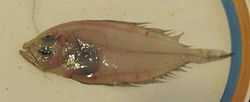Megrim
| Megrim | |
|---|---|
 | |
| Scientific classification | |
| Kingdom: | Animalia |
| Phylum: | Chordata |
| Class: | Actinopterygii |
| Order: | Pleuronectiformes |
| Family: | Scophthalmidae |
| Genus: | Lepidorhombus |
| Species: | L. whiffiagonis |
| Binomial name | |
| Lepidorhombus whiffiagonis (Walbaum, 1792) | |
The megrim or whiff (Lepidorhombus whiffiagonis) is a species of left-eyed flatfish in the family Scophthalmidae. It is found in the northeast Atlantic and Mediterranean Sea between 100 and 700 m (330 and 2,300 ft) below sea level.[1] It is caught commercially in some countries.[1]
Description
It can grow up to 60 cm (24 in) in length.[1] It is left-eyed, has a slightly larger head than usual in flatfish, and with a narrower body than usual. The dorsal and anal fins are relatively short and start far back on the body. The colouration is usually light brown with dark spots across the body and dark grey fins. It lacks the highly distinct dark spots found on the fins in its close relative, the four-spot megrim (L. boscii).
Habits
The megrim prefers a sandy or muddy sea floor. They are predators and eat small fish and squid and also consume crustaceans. In turn megrim are themselves prey for larger species such as sharks, seals and large cod. Megrim spawn in deep waters off Iceland and the west of Ireland, while there is a separate spawning population in the Mediterranean.[2]
Range
This species is found throughout European waters and the Northeast Atlantic including the Sea of the Hebrides.[3] Megrim are also found off the north coast of Africa and in parts of the Mediterranean.[2]
Commercial value
Megrim are commercially valuable and are caught by a number of nations around Europe. It is caught by bottom trawling and is directly targeted in some fisheries, whereas in others it is retained as a valuable bycatch.[4] France and Spain are the largest consumers of this species with most of the megrim caught in British water being exported to these nations. However, there has been a drive in Britain to get people to eat more megrim as a way of taking pressure off overexploited fish such as cod and haddock.[5] Megrim can be cooked in a number of different ways with grilling, baking, frying and poaching all effective ways of preparing this species. In the UK megrim is sometimes given an alternative name such as megrim sole and Cornish sole as a way of making this species more appealing to consumers.[2]
References
- ↑ 1.0 1.1 1.2 Froese, Rainer and Pauly, Daniel, eds. (2014). "Lepidorhombus whiffiagonis" in FishBase. May 2014 version.
- ↑ 2.0 2.1 2.2 "Megrim". Britishseafishing.co.uk. Retrieved 19 January 2014.
- ↑ C.Michael Hogan, (2011) Sea of the Hebrides. Eds. P. Saundry & C.J.Cleveland. Encyclopedia of Earth. National Council for Science and the Environment. Washington DC.
- ↑ "Species Guide - Megrim". Seafish. Retrieved 20 January 2014.
- ↑ "Pass notes No 2,992: The megrim". The Guardian. 13 June 2011. Retrieved 19 January 2014.